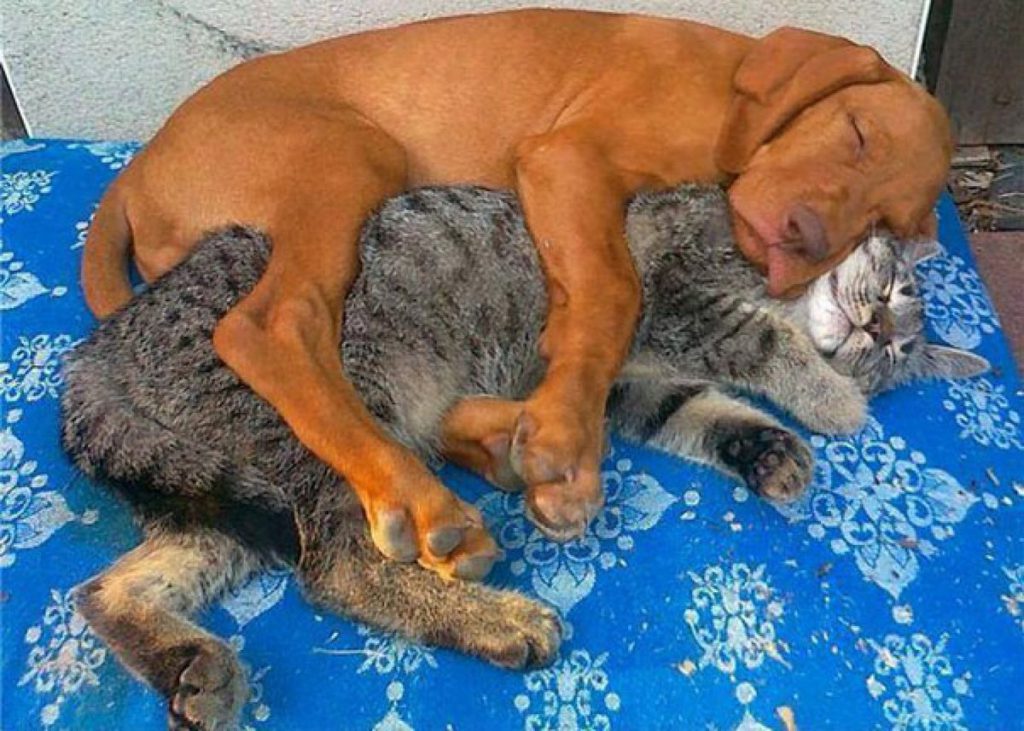
Dog and cat in the same house. Facts and myths about living together
Content
- Interspecific facts and myths
- Cats and dogs can't get along
- Cat and dog are in constant competition
- It's easier to introduce a cat into a house that already has a dog than vice versa.
- It is best if the cat and dog are brought up together.
- Animals are best left to their own devices - somehow they "get"
- A cat will most easily accept a puppy, especially a bitch
- How to adapt a dog and a cat to life together?
The saying "live like a dog with a cat" is perhaps as old as both of these species. It is established that these are two beings so different that they cannot function in harmony, and this will always mean quarrels and wars. We debunk myths and show how to teach dogs and cats to live together, how to tame each other.
Animal lovers are reportedly divided into dog lovers and cat lovers. However, there are many people who are reluctant to take sides and accept cats and dogs in their home and life. How to make them like each other? Is cross-species friendship possible?
Interspecific facts and myths
Cats and dogs can't get along
Nothing could be more wrong. Yes, these are species, often differing in needs and lifestyle, but they can live in the same house. Of course, both the animals and the house should prepare and control the situation properly for this. Whether it will be a strong friendship is difficult to predict at first, but you can tolerate each other. It all depends on the nature and attitude of these two specific creatures, but wisely and responsibly introducing a new fluffy household, we create fertile ground for future friendship.
Cat and dog are in constant competition
Not necessary. Contrary to popular belief, there is no place for misunderstanding in dogs and cats. The bowl is often a source of conflict between dogs, but not necessarily with cats. These animals do not see each other as rivals, as within the same species. Also, cat bowls can (and should) be kept out of the dog's reach so that one doesn't unknowingly fall on top of another's treat.
Nor does the lair have to be the place where the battle is fought. Cats often prefer their own inaccessible to dogs booths somewhere high, or scratching posts or shelves, and no need to use a dog den. The dog, in turn, often chooses the owner's bed or chair. Of course, in line with the saying that the grass is always greener on the other side, we sometimes see how a dog tries to squeeze into a cat's den, and a cat takes possession of a huge dog bed and does not think to give way. . However, there are usually so many places to sleep in the house that everyone will find something for themselves and will not interfere with others.
Attention and accustoming to the owner sometimes causes conflicts between dogs, and cats can wait until the dog is not around, and then come up to stroke the owner. However, you must ensure that each pet is gentle so that it does not feel lonely or forgotten.
It's easier to introduce a cat into a house that already has a dog than vice versa.
Truth. Cats are very territorial animals and are reluctant to share their kingdom. The appearance of a dog in our cat house may cause displeasure and disapproval in your cat. Dogs are not so much oriented to the ground as they are to the handler, so in most cases it will be a little easier to introduce a cat to the general space.
It is best if the cat and dog are brought up together.
Yes, this is indeed the best scenario. If we decide to bring a small kitten and a puppy into the house at the same time, we have almost a guarantee that the animals will have a good, close relationship. Both animals have blank slates—neither has bad experiences or prejudices about different species. They take their first steps together and will accompany each other in discovering a new world for each other, which often leads to deep friendship.
Animals are best left to their own devices - somehow they "get"
Absolutely not. Of course, you should give your pets the time and space to quietly get to know each other at their own pace. However, the development of the situation should be monitored and, if necessary, reacted, for example, by separating the animals. Of course, the cat will certainly run to the top cabinet in case of a dog attack, and the dog will hide under the sofa when the cat is persistent or aggressive, but each of them is at home and should feel comfortable and at ease. Safely. An animal that cannot defend itself must have appropriate support from its owner. The guardian should always watch the developing relationship until he is sure that the quadrupeds do not pose a threat to each other.
A cat will most easily accept a puppy, especially a bitch
Truth. It is believed that adult cats (regardless of gender) find it easier to make friends with a young bitch. It is also easier for them to accept puppies, as young dogs may just annoy them with constant harassment to play, but they do not pose a threat. An adult cat will often cope with the "education" of a young dog and clearly indicate its limits.
How to adapt a dog and a cat to life together?
A dog with a cat, or maybe a cat with a dog?
Aside from the ideal scenario where both species are raised together, we should always consider a few things before deciding whether or not to mate a dog with a cat in our home. If we have an adult cat at home, let's first find out how she reacts to the dog. If he has not been in contact with anyone so far, he does not know what to expect from him and may react with fear. It's a good idea to invite your friends home with your dog. It is best if it is a calm pet that does not have a strong attraction to chasing a cat. If our cat reacts positively, she will be curious about the new stranger, there is a chance that she will respond well to the new household. If he falls ill on such a visit due to a few days of stress, it will be much more difficult.
If, on the other hand, we have a dog, it is also worth checking its reaction to a cat. Our dog must have met cats on walks. If he reacts to them with interest rather than aggression, you can initially assume that he will not try to attack the cat. In this case, we can confirm this assumption also by visiting friends who have a cat.
Let's also try to find out as much as we can about the pet we are about to adopt into our home. If it is a feline or canine child, it is unlikely that he will show any resistance to contact with a member of another species. On the other hand, if we are adopting an adult cat, ask its existing owners about the pet's reaction to dogs and whether they can be tested before adopting. Similarly, when we bring home an adult dog.
Needs of the dog and cat
When the decision is made and the new animal is to move into our home, don't forget to prepare the common space. The cat should be able to hide somewhere high up so that she can observe her surroundings and feel safe. The dog must also have its own separate lair and/or a kennel cage, which will be his own place and refuge. Let's be careful when feeding. Animals eat best in silence, away from each other. We can place the cat bowls higher so that the dog does not have access to them. The same goes for cat litter, as some dogs like to eat the contents.
Both the dog and the cat should have their own Toyswhich the owner will also use. Don't forget to spend time with each pet. If we focus all of our attention on a new family member, the current one will feel rejected and may react with stress. Let's distribute the attention fairly.
If we run into problems adapting a new animal, let's consult a behaviorist who can help you deal with them. Quite often, a dog and a cat are combined in the same house, and if we do this wisely and responsibly, we can have a happy interspecies herd at home.
For other related articles, see My Passion for Animals.

